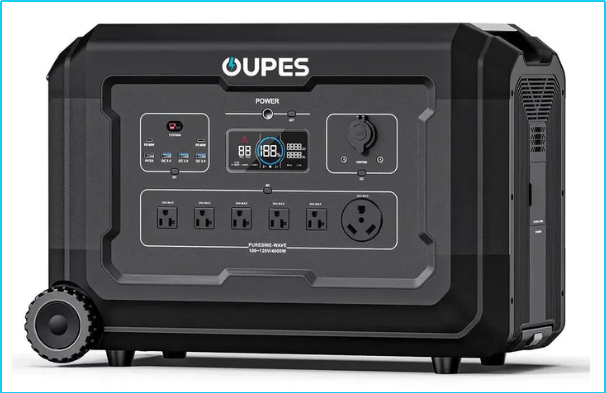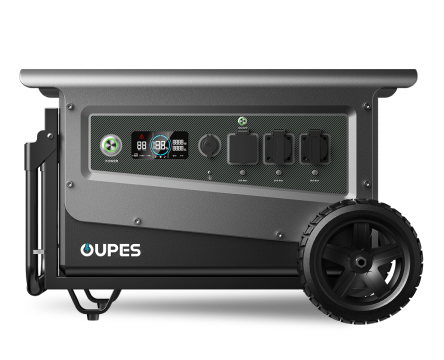
Table of Contents
- Introduction
- Understanding Voltage and Current
- Voltage Classifications and Standards
- Comparison: Low vs. Medium vs. High Voltage
- Applications in Energy Systems
- Voltage in Solar Generators and Portable Power Stations
- Safety and Handling Considerations
- Emerging Trends in Voltage Technology
- FAQ
Introduction
Voltage plays a central role in every electrical system — from tiny circuits to national power grids. Knowing how low, medium, and high voltage currents differ helps us understand how energy moves, how it’s stored, and how it can be used safely.
In renewable and portable energy applications — such as solar generators and portable power stations — voltage selection affects performance, efficiency, and safety. This guide provides a detailed look at voltage classifications, applications, and their importance in today’s energy landscape.
Understanding Voltage and Current
Voltage is the electrical potential difference between two points — essentially the "pressure" that pushes current through a circuit. Current, measured in amperes (A), is the flow of electric charge caused by that voltage.
Low Voltage (LV)
Low voltage refers to systems operating below 1,000 volts AC or 1,500 volts DC. This range is commonly used in homes, consumer electronics, and portable power systems. Examples include 12V or 24V DC systems in RVs and 120V or 230V AC for typical household outlets.
Medium Voltage (MV)
Medium voltage usually ranges between 1 kV and 35 kV. It is widely used for electrical distribution in commercial buildings, industrial sites, and local grids that connect high-voltage transmission systems to residential zones.
High Voltage (HV)
High voltage refers to systems above 35 kV. These systems are used for transmitting electricity across long distances with minimal loss. High voltage requires specialized insulation, switchgear, and maintenance to ensure safe operation.
Voltage Classifications and Standards
Voltage classifications are defined by international standards like those from the IEC (International Electrotechnical Commission) and the IEEE. These organizations define consistent voltage ranges to ensure electrical safety and compatibility across regions.
IEC Standard Voltage Ranges
- Low Voltage (LV): Up to 1,000V AC or 1,500V DC
- Medium Voltage (MV): 1,000V–35,000V
- High Voltage (HV): Above 35,000V
North American Standard (ANSI / IEEE)
- Low Voltage: Up to 600V
- Medium Voltage: 601V–69 kV
- High Voltage: 69 kV and above
Comparison: Low vs. Medium vs. High Voltage
| Category | Voltage Range | Main Uses | Advantages | Limitations |
|---|---|---|---|---|
| Low Voltage | 0–1,000V AC / 0–1,500V DC | Homes, electronics, portable solar generators | Safe, easy installation, widely compatible | Limited transmission range |
| Medium Voltage | 1–35 kV | Industrial systems, power distribution | Efficient over short distances | Requires professional handling |
| High Voltage | Above 35 kV | Transmission lines, large-scale grids | Low energy loss over long distances | High safety risk, expensive equipment |
Applications in Energy Systems
1. Low Voltage Applications
Low voltage systems are found in nearly every aspect of daily life — from lighting and computers to solar generators. Portable energy storage systems typically operate on 12V, 24V, or 48V DC to power appliances safely and efficiently.
2. Medium Voltage Applications
Medium voltage is used in commercial and industrial distribution networks. It bridges the gap between power generation and residential consumption, allowing efficient transfer of electricity with moderate safety requirements.
3. High Voltage Applications
High voltage transmission is essential for moving electricity over large distances. At higher voltages, current decreases for the same power, reducing resistance losses and improving efficiency. However, these systems require advanced safety and insulation measures.
Voltage in Solar Generators and Portable Power Stations
1. Why Voltage Matters in Solar Systems
In solar generator systems, voltage directly affects efficiency and charging speed. Higher voltage allows lower current flow for the same power, reducing internal losses and heat.
2. Common Voltage Ranges in Portable Power Stations
Most portable power stations operate in the low-voltage range for user safety. They typically feature internal 12V–48V LiFePO₄ batteries, combined with inverter technology to provide standard AC outputs for devices. Brands such as OUPES design their systems with optimized voltage management to ensure reliable operation for outdoor and emergency use.
3. Voltage Regulation and Efficiency
Charge controllers in solar generators manage input voltage from solar panels, keeping it within safe limits for charging. Modern Maximum Power Point Tracking (MPPT) controllers adjust voltage dynamically for maximum efficiency under varying sunlight conditions.
Safety and Handling Considerations
1. Electrical Shock Risks
Even low-voltage systems can cause harm under the wrong conditions. According to OSHA, contact with voltages above 50V poses potential shock hazards, especially in wet environments.
2. Insulation and Protection
Medium and high-voltage systems require specialized insulation materials, while portable systems rely on built-in protection circuits and insulated housings. Most portable solar generators use Battery Management Systems (BMS) to prevent overvoltage, short circuits, and overheating.
3. Proper Grounding and Connection
Grounding minimizes electrical faults and ensures system stability. For low-voltage systems like portable power stations, ensure all connections are dry, tight, and properly rated for the current load.
4. Certification and Compliance
Look for equipment that complies with standards from organizations such as UL, IEC, or CE. These certifications confirm that the product has undergone safety testing and meets performance requirements.
Emerging Trends in Voltage Technology
The global energy transition is driving the evolution of voltage systems. Higher-voltage DC technology is being adopted in grid-scale solar and wind systems for reduced losses. Meanwhile, portable systems are embracing 48V architectures to support higher-capacity batteries and faster charging.
Future innovations — such as intelligent load balancing and AI-based power management — will help optimize voltage in hybrid systems that combine solar, battery, and grid power. Manufacturers like OUPES are exploring smart monitoring systems to automatically adjust voltage output based on connected devices and real-time power demand.
FAQ
1. What voltage range is used in most homes?
Residential systems typically use 110V AC in North America and 230V AC in Europe — both considered low voltage.
2. Why is high voltage used for transmission?
High voltage reduces current for the same power, minimizing resistive losses and improving transmission efficiency.
3. What voltage do portable solar generators use?
Most operate internally between 12V and 48V DC and convert power to 110V or 230V AC for devices.
4. Are low-voltage systems completely safe?
No. While safer than high-voltage systems, low-voltage circuits can still cause electric shock or equipment damage if handled incorrectly.
5. What’s the advantage of a 48V system?
A 48V setup reduces current flow, improving energy efficiency and allowing for smaller cable sizes — ideal for larger solar generators.
6. What future improvements can we expect?
Advances in power electronics, smart control systems, and lithium battery technology will make voltage regulation more precise and energy transfer more efficient.




























